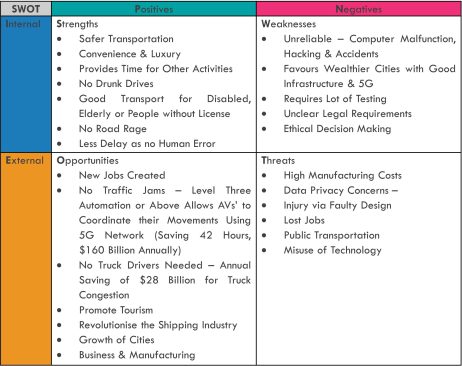Extended Project Qualification (EPQ)
Autonomous Vehicles
- 2019 - 2020
- A (A Level Grade)
Title: When and How Will Computers Take Over Humans in the Transportation Industry?
Summary: My Extended Project Qualification (EPQ) explored the rapidly developing field of autonomous vehicles (AVs). I investigated the growth and potential of this industry, focusing on the challenges and opportunities it presents. The project was inspired by the advancements in autonomous technology, particularly by companies like Waymo.
Objectives: The project aimed to provide a comprehensive understanding of autonomous vehicles, their history, current state, and future prospects. The specific objectives were:
- Understanding the background history of autonomous cars.
- Comprehending what autonomous vehicles are.
- Analysing and examining several latest autonomous vehicles that are currently released or under testing.
- Examining the most cost-effective and efficient power source for autonomous cars.
- Interpreting the technology used in the manufacturing of autonomous cars, such as AI.
- Understanding how the different levels of automation impact their release into the market.
- Investigating problems, issues, and benefits associated with the use of or production of autonomous cars.
- Conducting primary and secondary research to understand potential customers’ and experts’ views and preferences on autonomous vehicles.
- Analysing global motives, especially Dubai’s, in achieving an autonomous transportation world.
- Drawing conclusions and evaluations using research and existing resources to predict when and how autonomous vehicles might take over human-driven vehicles.
Relevance: This project has been instrumental in shaping my interest in technology and its intersection with society. The insights gained from this project were invaluable in my university studies and career in the field of technology and transportation.
TED Talk
Nico Larco's TED Talk
Book
‘Autonomy: The Quest to Build the Driverless Car – And How It Will Reshape Our World’
Research Papers/Reports
McKinsey & Company, MIT University, University of Michigan, IEEE
Reports by International Authorities
NHTSA, RTA, EEI, WHO
Online News
ABC News, Gulf News, CNN, YouTube, The Verge, CNBC
Other Online Sources
Medium, Wired, Sustainable America, VelodyneLidar
Expert Opinions
CEOs of Companies, University Professors
Survey
Used Microsoft Forms to Carry-out Survey
Government Sources
Dubai Future Foundation, NHTSA, RTA

SWOT Analysis: Autonomous vehicles (AVs) present a range of strengths, weaknesses, opportunities, and threats. They promise safer transportation, convenience, and time savings, but also face challenges such as reliability, infrastructure requirements, and ethical considerations. Despite these challenges, the benefits and opportunities of AVs outweigh the negatives, suggesting a promising future for this technology.

Impact on the World: The advent of AVs will revolutionize various industries and aspects of daily life. They will transform the shipping industry, promote tourism, and potentially reduce global warming if run on electricity. While AVs may eliminate some driving jobs, they could also create new, more rewarding opportunities.
Dubai’s Motives: Dubai is at the forefront of adopting AVs, with a strategy to transform 25% of all transportation to autonomous mode by 2030. This initiative is expected to save approximately $6 billion annually.
Conclusion:
In conclusion, it may take up to ten years, as supported by Dubai Future Foundation, RTA, some experts, and the survey conducted, for autonomous vehicles to hit the roads by taking over humans in the transportation industry. This is done using artificial intelligence, new sensors and cameras, and human-developed algorithms to create an image of its surroundings and respond using processors manufactured by other firms, such as NVIDIA and AMD.
However, autonomous vehicles may become a word of the past with the introduction of teleportation, the theory of transferring energy or matter from one point to another without changing the physical space among them; this leads to another research question:
Will Teleportation Ever Exist as a Method of Transportation?
Project Review
Problem
- Time Management
- Referencing & Bibliography
- Challenging to research and arrive at a conclusion about technology that has not yet been released
- Collecting information from different sources, analysing, and arriving at a conclusion
Solutions
- Use of a Gantt Chart
- Listing all references in a Word document and deciding based on authenticity and reliability
- Finding reliable information from trusted sources
- The project plan helped organise subheadings and conclusions
Potential Improvements
- Using an age-classified survey to further evaluate survey results
- A larger sample size with different nationalities would allow further analysis based on demographics
- Using other protect management tools, such as a network diagram
Reflecting in Hindsight
In hindsight, this project has significantly enhanced various skills, including report writing, researching, surveying, and technological expertise, and eased transition into University and a professional career.